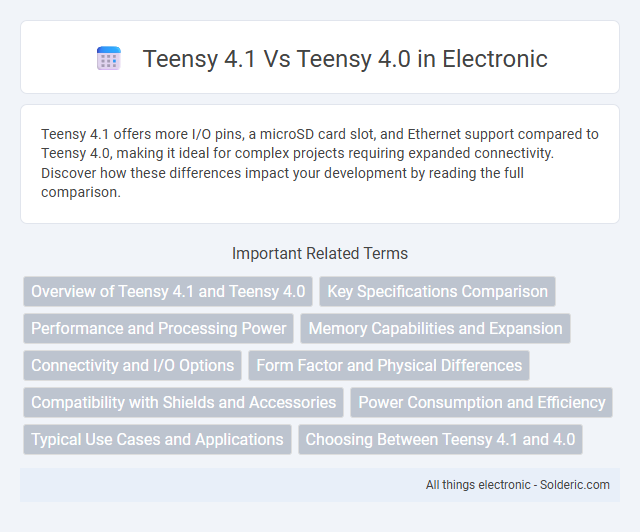Teensy 4.1 offers more I/O pins, a microSD card slot, and Ethernet support compared to Teensy 4.0, making it ideal for complex projects requiring expanded connectivity. Discover how these differences impact your development by reading the full comparison.
Comparison Table
| Feature | Teensy 4.1 | Teensy 4.0 |
|---|---|---|
| CPU | ARM Cortex-M7, 600 MHz | ARM Cortex-M7, 600 MHz |
| Flash Memory | 1 MB | 1 MB |
| RAM | 1024 KB | 1024 KB |
| USB | USB High-Speed (480 Mbit/s), Host & Device | USB High-Speed (480 Mbit/s), Host & Device |
| Ethernet | 10/100 Mbps Ethernet PHY support | No Ethernet support |
| MicroSD Slot | Yes, full-size MicroSD card slot | No MicroSD slot |
| Digital I/O Pins | 55 | 40 |
| Analog Inputs (ADC) | 14 | 14 |
| PWM Channels | 31 | 31 |
| Dimensions | 2.4" x 0.7" | 1.4" x 0.7" |
| Additional Features | CAN Bus, SD card support, Ethernet PHY pins, more I/O pins | Compact size, fewer I/O, no built-in SD or Ethernet hardware |
Overview of Teensy 4.1 and Teensy 4.0
Teensy 4.1 features an upgraded design with more pins, an Ethernet PHY, and a microSD card slot compared to Teensy 4.0, which offers a compact form with 40 I/O pins and no onboard microSD or Ethernet support. Both boards use the powerful 600 MHz ARM Cortex-M7 processor providing high performance for embedded applications. Teensy 4.1 is ideal for more complex projects requiring additional connectivity and storage options, while Teensy 4.0 suits compact designs with essential capabilities.
Key Specifications Comparison
The Teensy 4.1 features a 600 MHz ARM Cortex-M7 processor, 1024 KB RAM, and 8 MB of external flash, compared to the Teensy 4.0's 600 MHz ARM Cortex-M7 with 1024 KB RAM and 2 MB flash. Teensy 4.1 offers expanded I/O capabilities, including an extra SD card slot, more pins, and support for USB Host and Ethernet, which Teensy 4.0 lacks. Both boards share similar core performance, but Teensy 4.1's increased memory and peripheral options provide greater flexibility for complex projects.
Performance and Processing Power
The Teensy 4.1 offers enhanced performance and processing power compared to the Teensy 4.0, featuring a 600 MHz ARM Cortex-M7 processor that delivers faster computation speeds and improved real-time responsiveness. Both models support advanced instruction sets and DSP capabilities, but the Teensy 4.1 provides additional memory options, including more Flash and RAM, enabling better handling of complex applications and larger data sets. This makes the Teensy 4.1 particularly suitable for high-performance embedded systems requiring intensive signal processing and rapid data throughput.
Memory Capabilities and Expansion
The Teensy 4.1 offers significant enhancements over the Teensy 4.0 in memory capabilities, featuring 8MB of external PSRAM compared to the 4.0's lack of onboard expansion memory. It supports a microSD card slot for expandable storage, enabling more complex projects that require large data handling. The extra memory and expansion options make the Teensy 4.1 ideal for applications demanding higher buffer sizes and extensive data logging.
Connectivity and I/O Options
Teensy 4.1 offers enhanced connectivity and I/O options compared to Teensy 4.0, including additional Ethernet support via an onboard PHY and a microSD card slot for expanded storage capabilities. The I/O pin count on Teensy 4.1 increases to 55 digital pins, providing more flexibility for complex projects, while Teensy 4.0 has 40 digital I/O pins. Extra pins on Teensy 4.1 also support advanced communication interfaces like CAN bus and additional UART ports, boosting its integration potential in embedded systems.
Form Factor and Physical Differences
The Teensy 4.1 measures 2.4 x 0.7 inches, making it larger than the Teensy 4.0, which is 1.4 x 0.7 inches. Teensy 4.1 offers additional pins and a micro SD card slot, while Teensy 4.0 has a more compact design without the SD card feature. Both boards share the same pin pitch and header layout, allowing partial compatibility in custom projects despite size differences.
Compatibility with Shields and Accessories
Teensy 4.1 offers enhanced compatibility with a wider range of shields and accessories due to its additional pins and extended I/O capabilities compared to Teensy 4.0. While both models share a similar form factor, the Teensy 4.1's extra pins enable integration with more complex peripherals and expansion boards, allowing Your projects greater flexibility. If your setup requires extensive interfacing or future expansion, Teensy 4.1 provides superior shield compatibility without sacrificing backward support for Teensy 4.0 accessories.
Power Consumption and Efficiency
Teensy 4.1 offers improved power management features compared to Teensy 4.0, including more efficient low-power modes that can significantly reduce energy consumption during idle periods. While both boards utilize the same 600 MHz Cortex-M7 processor, Teensy 4.1's enhanced peripheral support and additional RAM allow for better task handling, which can translate into more efficient power usage under load. You can achieve longer battery life and more efficient performance with Teensy 4.1 in power-sensitive applications.
Typical Use Cases and Applications
The Teensy 4.1 expands on the Teensy 4.0's capabilities with additional I/O pins and memory, making it ideal for complex audio processing, high-performance robotics, and extensive sensor networks. You can leverage the Teensy 4.1's enhanced Ethernet support and microSD slot for advanced data logging and IoT projects requiring reliable networking and large storage. Both boards excel in real-time control and embedded development, but the Teensy 4.1 suits applications demanding scalable connectivity and increased peripheral integration.
Choosing Between Teensy 4.1 and 4.0
The Teensy 4.1 offers expanded features compared to the Teensy 4.0, including additional RAM, Ethernet support, and more I/O pins, making it ideal for complex projects requiring enhanced connectivity and memory capacity. The Teensy 4.0 is a compact option with similar processing power but fewer peripherals, suitable for space-constrained applications or simpler designs. Selecting between Teensy 4.1 and 4.0 depends on the project's size, memory demands, and need for extra interfaces like Ethernet or SD card support.
teensy 4.1 vs teensy 4.0 Infographic

 solderic.com
solderic.com